
Mae Hong Son: Thailand's Hidden Gem in the Mountains
Discover Mae Hong Son: A tranquil city in Northern Thailand known for its misty valleys, rich cultural heritage, stunning natural landscapes, and vibrant festivals.
Nestled in the mountainous region of Northern Thailand, Mae Hong Son is a serene and picturesque city that offers a unique escape from the hustle and bustle of more commercial tourist destinations. Known for its misty valleys and rich cultural heritage, Mae Hong Son captivates visitors with its tranquil beauty and traditional charm. Mae Hong Son is renowned for its stunning natural landscapes, including dense forests, rolling hills, and vibrant flower fields. This city is a haven for outdoor enthusiasts, offering numerous trekking routes, hot springs, and waterfalls to explore. The scenic Pai River adds to the city's allure, providing opportunities for rafting and relaxing boat rides. The city is also a cultural treasure trove, with a significant influence from the Shan and Karen ethnic groups. Mae Hong Son's temples, such as Wat Phra That Doi Kong Mu and Wat Chong Kham, reflect a unique blend of Thai and Burmese architectural styles. The local night market is a must-visit, offering an array of traditional crafts, delicious street food, and a glimpse into the daily life of the locals. Mae Hong Son is not just about natural beauty and culture; it is also known for its festivals, such as the Poi Sang Long Festival, where young boys are ordained as novice monks in a colorful and vibrant ceremony. The city's laid-back atmosphere, combined with its rich history and stunning scenery, makes it an ideal destination for those seeking a peaceful and enriching travel experience.
Local tips in Mae Hong Son
- Visit Mae Hong Son during the cool season (November to February) for the best weather and to see the city in its full natural beauty.
- Rent a motorbike for the day to explore the scenic Mae Hong Son Loop, a popular route that offers breathtaking views and charming villages.
- Don't miss the morning mist over the valleys; head to Wat Phra That Doi Kong Mu early for a stunning sunrise view.
- Try the local Shan cuisine, especially the kao soi (curry noodle soup) and the various unique snacks available at the night market.
- Book a stay in a traditional teak house or a homestay to experience local hospitality and get a deeper insight into the community's way of life.
Mae Hong Son: Thailand's Hidden Gem in the Mountains
Nestled in the mountainous region of Northern Thailand, Mae Hong Son is a serene and picturesque city that offers a unique escape from the hustle and bustle of more commercial tourist destinations. Known for its misty valleys and rich cultural heritage, Mae Hong Son captivates visitors with its tranquil beauty and traditional charm. Mae Hong Son is renowned for its stunning natural landscapes, including dense forests, rolling hills, and vibrant flower fields. This city is a haven for outdoor enthusiasts, offering numerous trekking routes, hot springs, and waterfalls to explore. The scenic Pai River adds to the city's allure, providing opportunities for rafting and relaxing boat rides. The city is also a cultural treasure trove, with a significant influence from the Shan and Karen ethnic groups. Mae Hong Son's temples, such as Wat Phra That Doi Kong Mu and Wat Chong Kham, reflect a unique blend of Thai and Burmese architectural styles. The local night market is a must-visit, offering an array of traditional crafts, delicious street food, and a glimpse into the daily life of the locals. Mae Hong Son is not just about natural beauty and culture; it is also known for its festivals, such as the Poi Sang Long Festival, where young boys are ordained as novice monks in a colorful and vibrant ceremony. The city's laid-back atmosphere, combined with its rich history and stunning scenery, makes it an ideal destination for those seeking a peaceful and enriching travel experience.
When is the best time to go to Mae Hong Son?
Iconic landmarks you can’t miss
Pai Canyon
Explore Pai Canyon, a stunning natural attraction in Northern Thailand, known for its unique rock formations and breathtaking views.

Yun Lai Viewpoint
Discover the breathtaking views and serene sunrise experiences at Yun Lai Viewpoint in Pai District, Mae Hong Son, Thailand.

Pang Oung
Explore the tranquil beauty of Pang Oung in Mae Hong Son, where stunning lakes and lush forests create a serene escape into nature's paradise.

Wat Phra That Doi Kongmu
Discover the tranquil beauty and spiritual significance of Wat Phra That Doi Kongmu, a must-visit Buddhist temple in Mae Hong Son, Thailand.

Ban Rak Thai
Explore the serene beauty, rich culture, and delightful tea of Ban Rak Thai, a hidden village gem in Mae Hong Son, Thailand.

Pai Walking Street
Discover the charm of Pai Walking Street, a bustling night market filled with delicious street food, unique crafts, and vibrant local culture in the heart of Pai District.

Thung Bua Tong Fields at Doi Mae U Kho
Discover the stunning Thung Bua Tong Fields at Doi Mae U Kho, where vibrant golden flowers bloom against breathtaking mountain scenery in Mae Hong Son, Thailand.

Tha Pai Memorial Bridge
Explore Tha Pai Memorial Bridge, a historical landmark in Pai District that offers stunning views and a glimpse into the rich history of the region.

Nam Lod Cave
Explore the stunning Nam Lod Cave in Mae Hong Son, Thailand - a captivating blend of natural beauty and rich cultural history awaits.

Tham Pla - Namtok Pha Suea National Park Office
Explore the beauty of Tham Pla - Namtok Pha Suea National Park, a natural paradise in Mae Hong Son featuring stunning waterfalls, diverse wildlife, and rich ecosystems.

Sai Ngam Natural Mineral Spring
Discover the healing waters and natural beauty at Sai Ngam Natural Mineral Spring in Pai, a must-visit destination for relaxation and rejuvenation.

Tha Pai Hot Spring
Discover the tranquil beauty and therapeutic waters of Tha Pai Hot Spring, a must-visit tourist attraction in Pai, Thailand.

Pha Bong Viewpoint
Discover the serene beauty of Pha Bong Viewpoint in Mae Hong Son, a scenic spot offering breathtaking views of lush valleys and majestic mountains.

Zu Tong Tae Bridge
Experience the breathtaking beauty of Zu Tong Tae Bridge, a stunning bamboo structure set against the vibrant rice fields of Mae Hong Son, Thailand.

Pam Bok Waterfall
Experience tranquility at Pam Bok Waterfall in Pai, Thailand, where nature's beauty meets serene adventure in a lush paradise.
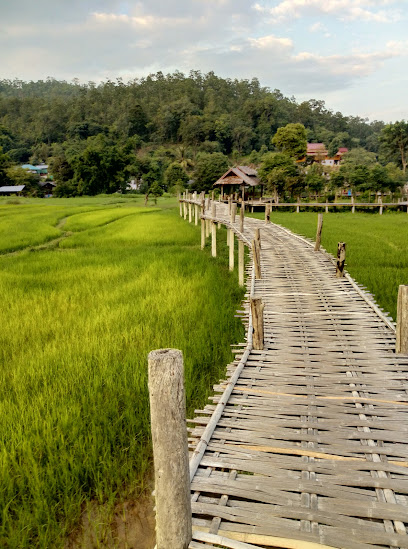
Unmissable attractions to see
Pang Oung
Explore the breathtaking beauty of Pang Oung, a tranquil escape in Mae Hong Son, Thailand, with stunning lake views and serene nature.

Wat Phra That Doi Kongmu
Discover the tranquility and cultural richness of Wat Phra That Doi Kongmu, a stunning Buddhist temple in Mae Hong Son with breathtaking views and unique architecture.

Ban Rak Thai
Discover the serene beauty of Ban Rak Thai, where lush tea plantations and rich culture await in the stunning mountains of Mae Hong Son.

Thung Bua Tong Fields at Doi Mae U Kho
Discover the stunning Thung Bua Tong Fields at Doi Mae U Kho, a breathtaking sunflower paradise in Thailand's Mae Hong Son province.

Tham Pla - Namtok Pha Suea National Park Office
Explore the serene beauty of Tham Pla - Namtok Pha Suea National Park, home to stunning waterfalls, vibrant fish caves, and rich biodiversity in Mae Hong Son.
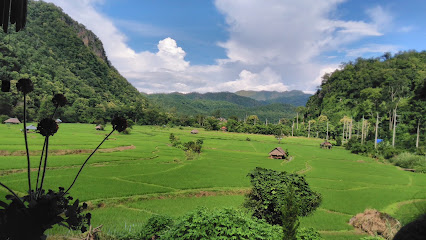
Zu Tong Tae Bridge
Explore the enchanting Zu Tong Tae Bridge in Mae Hong Son, where nature's beauty meets cultural heritage amidst lush green rice fields.

Pam Bok Waterfall
Explore the serene beauty of Pam Bok Waterfall in Pai, Thailand, where crystal-clear waters and breathtaking landscapes await every traveler.
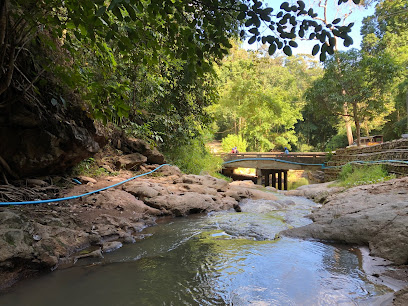
Pang Tong Royal Forest Park Project 2 (Pang Oung)
Explore the enchanting beauty of Pang Tong Royal Forest Park, a tranquil paradise in Mae Hong Son, Thailand, perfect for nature lovers and adventurers.

หมู่บ้านกระเหรี่ยงคอยาว
Discover the serene beauty and rich culture of Mae Hong Son, a hidden gem in Northern Thailand, perfect for an unforgettable travel experience.
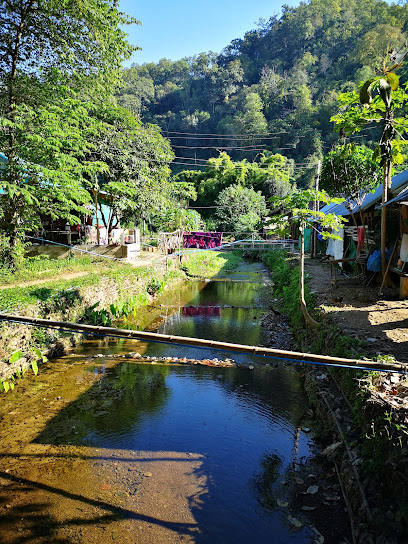
Namtok Mae Surin National Park
Explore the natural wonders of Namtok Mae Surin National Park in Mae Hong Son, Thailand, where lush landscapes and stunning waterfalls await.
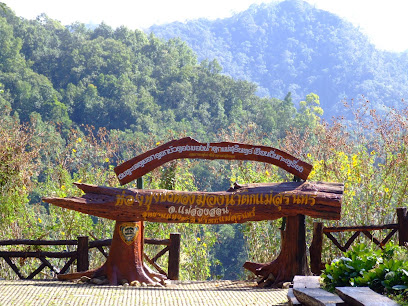
Mae La Luang Viewpoint
Discover the breathtaking beauty of Mae La Luang Viewpoint, a tranquil escape in Mae Hong Son with stunning panoramic views and serene landscapes.

Mueang Paeng Hot Spring
Experience the rejuvenating warmth of Mueang Paeng Hot Spring, a serene paradise in Pai District, Mae Hong Son, offering natural beauty and relaxation.

Pha Bong Hot Spring
Discover serenity at Pha Bong Hot Spring, a natural oasis in Mae Hong Son perfect for relaxation and rejuvenation.

Doi Pui Co
Discover the breathtaking views and rich culture of Doi Pui Co, a mountain retreat in Mae Hong Son, Thailand, perfect for nature and adventure lovers.

Thai-Japan Friendship Memorial Hall Khumyuam
Discover the Thai-Japan Friendship Memorial Hall, where history and culture intertwine in the heart of Khun Yuam, Mae Hong Son.

Essential places to dine
Om Garden Cafe
Experience culinary bliss amidst nature's beauty at Om Garden Cafe in Pai - where every bite is infused with local charm.

Two Sisters Restaurant
Discover authentic Thai cuisine at Two Sisters Restaurant in Pai—where fresh ingredients meet warm hospitality in a charming setting.

Bai Fern Restaurant
Experience the best of authentic Thai cuisine at Bai Fern Restaurant in Mae Hong Son—where every dish tells a story.

Salween River Restaurant
Experience authentic Asian flavors at Salween River Restaurant, where delicious Thai cuisine meets stunning riverside views in Mae Hong Son.

Inthira Restaurant
Experience authentic Thai cuisine at Inthira Restaurant in Mae Sariang - where tradition meets modernity amidst breathtaking scenery.
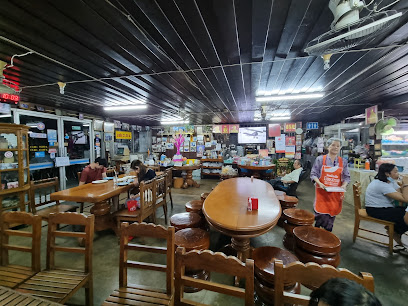
Baanpai restaurant
Experience the essence of Thai cuisine at Baanpai Restaurant in Pai - where authentic flavors meet warm hospitality.

Blue Ox
Discover culinary excellence at Blue Ox in Pai - where traditional Thai flavors meet innovative cuisine amidst stunning mountain views.

The House Cafe' Home stead
Discover delightful organic dishes and aromatic brews at The House Cafe' Homestead in picturesque Pai - a haven for foodies and coffee lovers.

Na's Kitchen
Discover authentic Northern Thai cuisine at Na's Kitchen in Pai – where every dish tells a story of flavor and tradition.
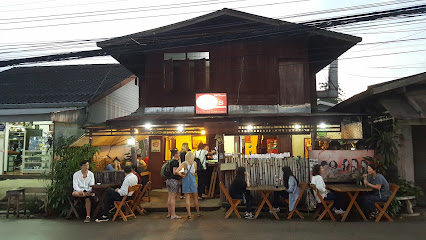
Sunset View Pai
Experience breathtaking sunsets and delightful flavors at Sunset View Pai in Thailand's picturesque Mae Hong Son province.

Carrot On The Moon
Discover Carrot On The Moon: A charming café in Pai offering delightful breakfasts, artisanal cakes, and an inviting atmosphere for every traveler.
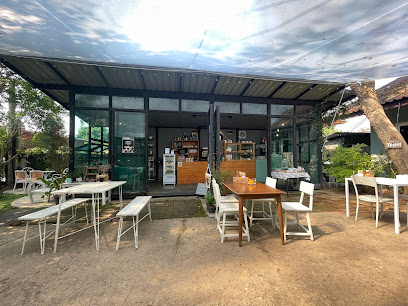
Baan Song Thai Restaurant
Experience authentic Thai cuisine at Baan Song Thai Restaurant in Mae Hong Son - where local flavors meet warm hospitality.

Pa Hom Noodle
Experience the authentic taste of Thailand at Pa Hom Noodle - where tradition meets flavor in every bowl.

Pai River Corner
Discover exquisite Thai flavors and breathtaking views at Pai River Corner, your ultimate dining destination in Pai.

Pizza Primavera
Experience authentic Italian flavors at Pizza Primavera in Mae Hong Son - where every bite transports you to Italy amidst stunning Thai landscapes.

Markets, malls and hidden boutiques
Yun Lai Viewpoint
Discover the enchanting beauty of Yun Lai Viewpoint in Pai, Thailand, where breathtaking vistas and serene landscapes await every traveler.

Pai Walking Street
Discover the vibrant night market of Pai Walking Street, where local culture, delicious food, and unique shopping come together in a lively atmosphere.

Zu Tong Tae Bridge
Discover the breathtaking beauty and cultural richness of Zu Tong Tae Bridge in Mae Hong Son, Thailand, a must-see tourist attraction.

Pai Village Boutique Resort
Experience the serene beauty and vibrant culture of Pai at the Pai Village Boutique Resort, your perfect getaway in Mae Hong Son, Thailand.

Huay Sua Thao: Kayan (long neck) village
Explore the rich culture and vibrant market of Huay Sua Thao, home to the Kayan people and their exquisite traditional handicrafts.
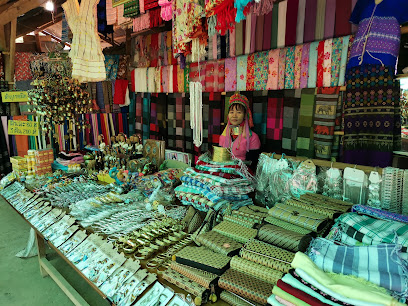
Coffee Morning
Experience the charm of Mae Hong Son at Coffee Morning, where artisan coffee meets local artistry in a cozy atmosphere.

Kadkam plaza Maehongson
Experience the vibrant local culture and flavors at Kadkam Plaza, Mae Hong Son's beloved supermarket, where shopping meets tradition.

Cross Tattoo Studio
Discover the vibrant artistry and exceptional service at Cross Tattoo Studio in Pai, where your tattoo dreams become reality.

Lan View Coffee
Experience the serene ambiance of Lan View Coffee in Mae Hong Son, where delightful brews meet unique local souvenirs amidst breathtaking views.

Aerie Lodge บ้านอินทรี
Discover tranquility at Aerie Lodge in Mae Hong Son, where comfort meets nature amidst stunning mountain landscapes.

Ban Nin Tra Mae Hong Son
Discover the vibrant flavors of Vietnam at Ban Nin Tra Mae Hong Son, where authentic dishes meet warm hospitality in a charming setting.

one off coffee
Discover the essence of Mae Hong Son with exceptional brews and a cozy atmosphere at One Off Coffee, the perfect spot for coffee lovers.

Siam Books
Discover literary treasures at Siam Books, Pai's charming bookstore with an extensive collection of local and international titles.

Mae Hong Son Walking Street
Experience the enchanting Mae Hong Son Walking Street, where local flavors and crafts come together in a vibrant evening market.

Coffee for U - soi3
Discover the perfect blend of relaxation and local flavor at Coffee for U, Mae Hong Son's beloved coffee haven.

Essential bars & hidden hideouts
Sunset Bar
Experience breathtaking sunsets and a vibrant atmosphere at Sunset Bar in Pai, the perfect spot for relaxation and socializing.

Don't Cry
Experience the vibrant nightlife of Pai at Don't Cry Bar, where eclectic music and warm hospitality create unforgettable memories.

JIKKO BAR
Experience the vibrant atmosphere and stunning views at JIKKO BAR, a perfect spot for cocktails and relaxation in the heart of Pai, Thailand.

Boom Bar
Discover the vibrant nightlife of Pai at Boom Bar, where stunning views, refreshing drinks, and lively atmosphere await.

Yellow Sun
Discover the lively atmosphere of Yellow Sun Bar in Pai, a perfect spot for cocktails and live music in the heart of Thailand's stunning landscapes.

Almost Famous
Discover Almost Famous, Pai's vibrant cocktail bar offering unique drinks and a lively atmosphere, perfect for an unforgettable night out.

Valhalla Bar
Discover the lively ambiance of Valhalla Bar in Pai, where local culture meets creative cocktails in a breathtaking setting.

Ching Ching Cafe' Maesariang
Experience the charm of Ching Ching Café in Mae Sariang, where friendly service meets affordable drinks in a cozy atmosphere.

Paradise Bar
Discover the lively and eclectic atmosphere of Paradise Bar in Pai, Thailand, where fire shows meet a secret drink menu for unforgettable nights.

Pai Pub
Experience the vibrant nightlife of Pai at Pai Pub, where delightful drinks and live music create the perfect atmosphere for relaxation and fun.
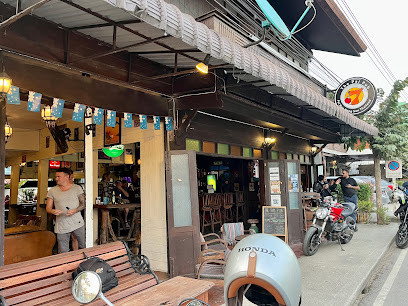
The Bottle & Cat’s Whiskers
Experience the vibrant nightlife of Pai at The Bottle & Cat’s Whiskers, where fine wines, cocktails, tapas, and live music come together.

Reggae Pai
Immerse yourself in the vibrant sounds of live music at Reggae Pai, a must-visit bar in the heart of Pai's enchanting nightlife.

นั่งเล่า เม้าท์มอย
Discover the lively ambiance and local flavors at นั่งเล่า เม้าท์มอย, a must-visit bar in Mae Hong Son for tourists seeking fun and relaxation.
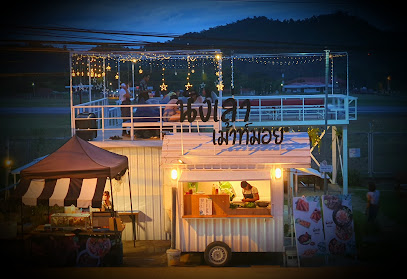
Humble bar pai
Discover the vibrant atmosphere of Humble Bar Pai, where refreshing drinks and live music create the perfect retreat in the heart of Mae Hong Son.

Good View Bar & Restaurant
Discover the culinary delights at Good View Bar & Restaurant, where exquisite flavors meet stunning lakeside views in Mae Hong Son.

Travel experiences inspired by this city
Explore more travel diariesLocal Phrases
-
- Helloสวัสดี
[sawadee] - Goodbyeลาก่อน
[la kon] - Yesใช่
[chai] - Noไม่
[mai] - Please/You're welcomeโปรด/ยินดีต้อนรับ
[prode/yindee ton rap] - Thank youขอบคุณ
[kop khun] - Excuse me/Sorryขอโทษ
[kor toht] - How are you?สบายดีไหม
[sabai dee mai] - Fine. And you?ดีครับ คุณล่ะ
[dee krub kun la] - Do you speak English?คุณพูดภาษาอังกฤษได้ไหม
[kun poot pah saa angkrit dai mai] - I don't understandฉันไม่เข้าใจ
[chan mai kao jai]
- Helloสวัสดี
-
- I'd like to see the menu, pleaseขอดูเมนูหน่อยครับ
[kor doo menu noi krub] - I don't eat meatฉันไม่กินเนื้อ
[chan mai kin neuua] - Cheers!ชนเครื่องดื่ม
[chon kreung deum] - I would like to pay, pleaseขอจ่ายเงินหน่อยครับ
[kor jai ngeun noi krub]
- I'd like to see the menu, pleaseขอดูเมนูหน่อยครับ
-
- Help!ช่วยด้วย
[chuay duay] - Go away!ไปออก
[pai ok] - Call the Police!โทรตำรวจ
[toh tam-ruat] - Call a doctor!โทรหมอ
[toh mo] - I'm lostฉันหลงทาง
[chan long tang] - I'm illฉันไม่สบาย
[chan mai sabai]
- Help!ช่วยด้วย
-
- I'd like to buy...ฉันอยากซื้อ...
[chan yak sue...] - I'm just lookingฉันแค่ดู
[chan kae doo] - How much is it?ราคาเท่าไหร่
[ra-ka tao rai] - That's too expensiveแพงเกินไป
[paeng geun pai] - Can you lower the price?ลดราคาได้ไหม
[lot ra-ka dai mai]
- I'd like to buy...ฉันอยากซื้อ...
-
- What time is it?ตอนนี้เวลาเท่าไหร่
[ton nee welaa tao rai] - It's one o'clockเป็นโมงเดียว
[pen mong diao] - Half past (10)ครึ่งหนึ่ง
[kreung neung] - Morningเช้า
[chao] - Afternoonบ่าย
[bai] - Eveningเย็น
[yen] - Yesterdayเมื่อวาน
[meua wan] - Todayวันนี้
[wan nee] - Tomorrowพรุ่งนี้
[phrung nee] - 1หนึ่ง
[neung] - 2สอง
[song] - 3สาม
[sam] - 4สี่
[see] - 5ห้า
[ha] - 6หก
[hok] - 7เจ็ด
[chet] - 8แปด
[paet] - 9เก้า
[gao] - 10สิบ
[sip]
- What time is it?ตอนนี้เวลาเท่าไหร่
-
- Where's a/the...?...อยู่ที่ไหน
[...yoo tee nai] - What's the address?ที่อยู่คืออะไร
[tee yoo keu arai] - Can you show me (on the map)?ช่วยแสดงให้ฉันดูได้ไหม
[chuay sa-deng hai chan do dai mai] - When's the next (bus)?รถเมล์ต่อไปเมื่อไหร่
[rot mel tor pai meua rai] - A ticket (to ....)บัตรโดยสาร (ไปที่...)
[bat doy saan (pai tee...)]
- Where's a/the...?...อยู่ที่ไหน
History of Mae Hong Son
-
Mae Hong Son was established in the early 19th century by Shan people from Burma (now Myanmar). Known originally as Ban Mae Rong Son, it served as a base for elephant training for the royal family of Chiang Mai. Over time, it developed into a bustling town with a unique blend of Shan and Thai cultures.
-
The Shan people have had a profound influence on the culture, architecture, and traditions of Mae Hong Son. Their presence is evident in the town's ornate temples, such as Wat Chong Kham and Wat Chong Klang, which feature intricate Shan-style designs and artwork.
-
Elephants have played a significant role in the history of Mae Hong Son. Historically, the area was known for its elephant training camps, where elephants were trained for logging and ceremonial purposes. This tradition continues today with elephant sanctuaries and trekking camps that attract tourists from around the world.
-
During World War II, Mae Hong Son found itself under Japanese occupation. The region was strategically significant due to its proximity to Burma, and it became a route for Japanese forces moving supplies and troops. The local population endured hardships during this period, but the town remained resilient.
-
In the latter half of the 20th century, Mae Hong Son began to emerge as a popular tourist destination. Its remote location, stunning natural landscapes, and rich cultural heritage drew visitors seeking an authentic and off-the-beaten-path experience. The development of infrastructure, including improved roads and accommodations, has facilitated tourism, while efforts have been made to preserve the area's unique charm.
-
Mae Hong Son is renowned for its annual Poi Sang Long Festival, a significant cultural event for the Shan community. This festival, also known as the Festival of the Crystal Sons, involves the ordination of young boys as novice monks. It is a vibrant and colorful celebration featuring elaborate processions, traditional music, and dance, reflecting the deep spiritual and cultural traditions of the region.
-
Mae Hong Son is home to various hill tribe communities, including the Karen, Lisu, Lahu, and Hmong. Each tribe has its own distinct customs, languages, and traditional attire. The interaction between these tribes and the local population has enriched the cultural tapestry of Mae Hong Son, making it a fascinating destination for those interested in ethnography and indigenous cultures.
-
In recent years, Mae Hong Son has seen a gradual shift towards modernization. While efforts are made to maintain traditional ways of life, the influence of technology and globalization is evident. The local government and communities are working together to balance development with cultural preservation, ensuring that Mae Hong Son retains its unique identity amidst change.
Mae Hong Son Essentials
-
Mae Hong Son is located in the remote mountainous region of northern Thailand. The most common way to reach Mae Hong Son is by flying from Bangkok to Mae Hong Son Airport (HGN). There are daily flights operated by domestic airlines. Alternatively, you can take a bus from Chiang Mai, which takes approximately 6-8 hours via a scenic but winding route through the mountains. Some travelers also choose to rent a car or motorbike for a more flexible journey.
-
Within Mae Hong Son, transportation options include renting a motorbike, bicycle, or car. Local taxis and songthaews (shared taxis) are also available for hire. Motorbikes are a popular choice for exploring the town and its surrounding areas due to the flexibility they offer. For longer distances, there are buses and minivans that connect Mae Hong Son with other towns and tourist spots in the region.
-
The official currency in Thailand is the Thai Baht (THB). Credit cards are widely accepted in hotels, larger restaurants, and shops, but it is advisable to carry cash for smaller establishments and local markets. ATMs are available in Mae Hong Son, and currency exchange services can be found in banks and some hotels. It is recommended to carry enough cash, especially when traveling to rural areas.
-
Mae Hong Son is generally considered safe for tourists. However, it is important to take standard precautions. Avoid walking alone at night in unfamiliar areas, and keep an eye on your belongings in crowded places. While crime rates are low, it is always best to stay vigilant. There are no specific high-crime areas targeting tourists in Mae Hong Son.
-
In case of an emergency, dial 191 for police assistance and 1669 for medical emergencies. Mae Hong Son Hospital provides medical services, and there are several clinics and pharmacies in town for minor health issues. It is advisable to have travel insurance that covers medical emergencies. For minor issues, local pharmacies can provide over-the-counter medications.
-
Fashion: Do dress modestly, especially when visiting temples. Avoid wearing revealing clothing. Religion: Do show respect at religious sites. Remove your shoes before entering temples and avoid pointing your feet at Buddha images. Public Transport: Do be polite and offer seats to the elderly or monks. Don't eat or drink on public transport. Greetings: Do greet people with a traditional Thai 'wai' (a slight bow with hands pressed together). Eating & Drinking: Do try local dishes and accept food offerings graciously. Don't refuse hospitality, as it can be considered impolite.
-
To experience Mae Hong Son like a local, visit the morning market where you can sample local delicacies and buy fresh produce. Engage with locals, who are often friendly and willing to share stories about their culture and history. Don't miss visiting the various temples and the scenic viewpoints such as Wat Phra That Doi Kong Mu. For a unique experience, participate in a traditional Karen or Shan festival if your visit coincides with one.
Trending Landmark in Mae Hong Son
-
Pai Canyon
-
Yun Lai Viewpoint
-
Pang Oung
-
Wat Phra That Doi Kongmu
-
Ban Rak Thai
-
Pai Walking Street
-
Thung Bua Tong Fields at Doi Mae U Kho
-
Tha Pai Memorial Bridge
-
Nam Lod Cave
-
Tham Pla - Namtok Pha Suea National Park Office
-
Sai Ngam Natural Mineral Spring
-
Tha Pai Hot Spring
-
Pha Bong Viewpoint
-
Zu Tong Tae Bridge
-
Pam Bok Waterfall
Nearby Cities to Mae Hong Son
-
Things To Do in Pai
-
Things To Do in Chiang Mai
-
Things To Do in Kyaiktiyo
-
Things To Do in Hpa-An
-
Things To Do in Naypyidaw
-
Things To Do in Inle Lake
-
Things To Do in Chiang Rai
-
Things To Do in Kalaw
-
Things To Do in Pyay
-
Things To Do in Yangon
-
Things To Do in Sukhothai
-
Things To Do in Nan
-
Things To Do in Ngapali
-
Things To Do in Pyin Oo Lwin
-
Things To Do in Mandalay















